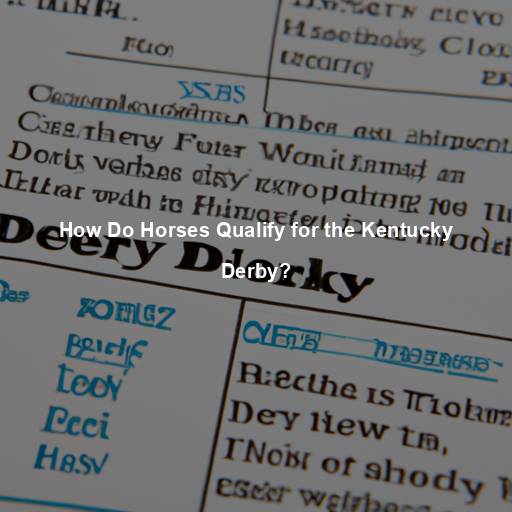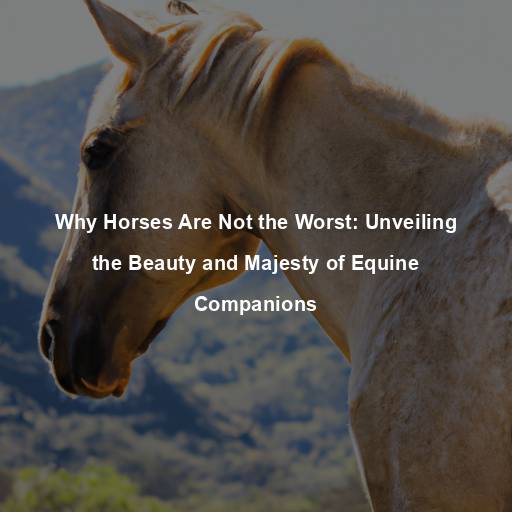How Do Horses Qualify for the Kentucky Derby?
Last Updated on November 5, 2023 by Evan
Contents [hide]
- 1 Understanding the Prestigious Kentucky Derby
- 2 Step 1: Points System
- 3 Step 2: Entry and Acceptance Process
- 4 Step 3: The Kentucky Derby Draw
- 5 Step 4: The Kentucky Derby Experience
- 6 Step 1: Points System – A Fair and Objective Qualification Process
- 7 Step 2: Entry and Acceptance Process – Formalizing Participation
- 8 Step 3: The Kentucky Derby Draw – Determining Starting Positions
- 9 Step 4: The Kentucky Derby Experience – A Thrilling Spectacle
- 10 FAQs: How do Horses Qualify for the Kentucky Derby?
- 10.1 What is the Kentucky Derby?
- 10.2 How can a horse qualify for the Kentucky Derby?
- 10.3 How long is the qualifying period for the Kentucky Derby?
- 10.4 How many points are required to qualify for the Kentucky Derby?
- 10.5 Do all horses that accumulate enough points get to run in the Kentucky Derby?
- 10.6 Can horses qualify for the Kentucky Derby through other means?
- 10.7 Are there any specific age or breed restrictions for horses to qualify?
- 10.8 What happens if a qualified horse gets injured or cannot participate in the Kentucky Derby?
- 10.9 How many horses are typically entered into the Kentucky Derby?
- 10.10 Is there a deadline for horses to qualify for the Kentucky Derby?
Understanding the Prestigious Kentucky Derby
There’s a mystique surrounding the renowned Kentucky Derby, an event that exudes elegance and grandeur. Marked by the affectionate moniker, “Run for the Roses,” this race holds a hallowed place in the world of horse racing, stirring passion and curiosity in equal measure. Our inquisitive minds often ponder how horses earn the chance to gallop on that prestigious track in Churchill Downs, Louisville, every first Saturday of May. Brace yourself as we embark on a journey through the labyrinthine process that determines the coveted spots in the Kentucky Derby starting gate.
The Road to the Kentucky Derby
The journey to the Kentucky Derby begins long before the horses step foot onto the track. To ensure fairness and maintain the caliber of competition, a series of qualifying races is held throughout the year. These races collectively form what is known as the “Road to the Kentucky Derby”.
Step 1: Points System
Earning Points for the Kentucky Derby
The first step in determining which horses qualify for the Kentucky Derby is the establishment of a points system. Starting in the fall of the previous year, a series of designated races are assigned a specific point value, ranging from 10 to 100 points, depending on the race’s significance. The horses that finish in the top four positions in these races earn points towards their qualification for the Kentucky Derby.
Accumulating Points
As the racing season progresses, horses accumulate points based on their performances in these designated races. The higher the finishing position, the more points they earn. The points system aims to reward consistency and success in key races leading up to the Kentucky Derby.
The Top 20
With the intense qualifying races drawing to a close, the highly anticipated Kentucky Derby field is almost set. The top 20 horses, meticulously chosen based on their stellar performances throughout the season, have earned the coveted opportunity to showcase their skill at this prestigious event. This rigorous selection process ensures that only the crème de la crème of equine athleticism will grace the hallowed grounds of this revered race. Get ready to witness a clash of titans as these formidable contenders vie for the ultimate triumph in the sport of kings.
Step 2: Entry and Acceptance Process
Submitting Nominations
The excitement of the Kentucky Derby reaches its crescendo as horse owners and trainers eagerly await the moment to solidify their contenders. With bated breath, they carefully compile the necessary documents for the official nomination, marking the beginning of a meticulous journey. As the world anticipates the grandeur of the race, the nomination process sets the stage, unfolding months in advance, shrouded in a veil of intrigue and anticipation.
The Entry Fee
As equestrian enthusiasts eagerly await the prestigious Kentucky Derby, a crucial element propels horses towards the coveted starting line – the entry fee. This essential payment, subject to an ever-shifting terrain of the racing world, ensures a place in the esteemed event while shouldering the financial burdens involved and fueling the grandeur of the prize bestowed upon triumphant contenders. With anticipation galloping through the air, owners navigate the intricate fluctuation of fees, cementing their equine champions’ position in the illustrious spectacle.
Oversubscribed Field
In some instances, more than 20 horses may be nominated and have enough points to qualify for the Kentucky Derby. When this occurs, the field becomes oversubscribed. In such cases, the highest point earners are given priority, and the remaining horses are placed on an “also-eligible” list. If any of the top 20 horses withdraw before the race, the horses on the “also-eligible” list can take their place.
Scratches and Substitutes
Imagine the curiosities that arise when fate intervenes and a horse is unable to prance onto the hallowed grounds of the Kentucky Derby. Fear not, for a mystical remedy exists! Hidden within the depths of the “also-eligible” list lies a substitute, patiently awaiting its moment of glory. This arcane practice guarantees that the cavalry of noble steeds remains steadfast at a full count of twenty, even in the face of untimely withdrawals.
Step 3: The Kentucky Derby Draw
Post Position Draw
As the date of the highly anticipated Kentucky Derby draws closer, the enthralling process of determining the post positions awaits the competitors. With a touch of unpredictability, the draw is a tantalizing event that sparks both exhilaration and suspense amongst the horses and their eager audience. Days before the iconic race commences, the tension mounts as the random selection takes place, keeping everyone on their toes and amplifying the intrigue surrounding this prestigious sporting event.
Strategic Importance
When it comes to horse racing, the post position draw holds immense importance in determining the fate of these majestic creatures on the track. It’s like a mysterious puzzle that unwraps itself, adding bursts of uncertainty and anticipation to the already perplexing world of horse racing. Each post position has its own unique history, with certain spots being hailed as more advantageous – like hidden treasure maps guiding horses towards a better starting point. Trainers and jockeys wholeheartedly immerse themselves in analyzing this enigmatic draw, exploring strategic pathways that could potentially unravel the secret to their horse’s triumphant performance.
Step 4: The Kentucky Derby Experience
The Run for the Roses
As the sun sets on countless dawn-to-dusk days of relentless training, the momentous occasion we’ve all been waiting for dawns upon us with a tantalizing mix of grandeur and uncertainty. The Kentucky Derby, a beacon of equestrian excellence, commences with a symphony of pounding hooves and thunderous applause that echoes across the globe, uniting horse racing enthusiasts in collective awe. The triumphant stallion that crosses the finish line first, their sinewy muscles glistening with sweat, not only seizes the illustrious title of Derby champion but also etches their indomitable spirit into the tapestry of racing history, forever igniting a flicker of fiery passion within the hearts of onlookers.
The Pursuit of the Triple Crown
When it comes to the Kentucky Derby, victory is just the tip of the iceberg for ambitious contenders aiming for the illustrious Triple Crown. The Triple Crown, a trifecta of races including the Kentucky Derby, the Preakness Stakes, and the Belmont Stakes, beckons those with a taste for glory. Earning the title of Triple Crown champion requires conquering all three races in a single year, a rare feat achieved by only a chosen few in the equine world. This exclusive accomplishment intensifies the intrigue and prestige surrounding the iconic Kentucky Derby.
The Significance of the Kentucky Derby
The Kentucky Derby holds a special place in the hearts of horse racing enthusiasts. It represents the pinnacle of the sport and is steeped in tradition and history. The race is not only a test of speed and endurance but also a celebration of the bond between humans and horses. The horses that qualify for the Kentucky Derby have proven themselves to be among the best of their generation, and their journey to the starting gate is filled with excitement and anticipation.
Step 1: Points System – A Fair and Objective Qualification Process
Points Allocation
The points system used to determine the Kentucky Derby field ensures a fair and objective qualification process. By assigning specific point values to designated races, the system rewards horses that perform well in key races leading up to the Derby. This approach emphasizes consistency and success in races that are considered important indicators of a horse’s potential.
Evaluating Performance
As the racing season gallops along, these magnificent equine athletes strive to amass points that act as luminescent markers of their prowess on the track. Meticulously etched out through their performances in specially chosen races, these points hold the key to unlocking the majestic gates of the celebrated Kentucky Derby. The diligent accumulation of these coveted points intensifies the horses’ prospects of securing a place among the crème de la crème in the Derby’s awe-inspiring field, heightening intrigue and bewilderment with each point earned.
A Competitive Field
By the end of the qualifying races, the top 20 horses with the highest points total earn the opportunity to compete in the Kentucky Derby. This ensures that the field consists of the most talented and accomplished horses, providing a thrilling and competitive race for both participants and spectators.
Step 2: Entry and Acceptance Process – Formalizing Participation
Formal Nominations
After the points have been tallied, horse owners and trainers must submit a formal nomination to enter their horse into the Kentucky Derby. This nomination serves as an official declaration of intent to participate in the race. The nomination process typically begins several months before the event, allowing ample time for preparations and logistical arrangements.
Financial Commitment
To solidify their horse’s spot in the Kentucky Derby, owners must pay an entry fee. This fee covers the expenses associated with participating in the event and contributes to the prize money awarded to the top finishers. The entry fee serves as a commitment from owners to support the race and ensures their horse’s eligibility to compete.
Managing Oversubscription
In some instances, more than 20 horses may be nominated and have enough points to qualify for the Kentucky Derby. When this occurs, the field becomes oversubscribed. In such cases, the highest point earners are given priority, and the remaining horses are placed on an “also-eligible” list. This list includes substitute horses that can take the place of any horse that withdraws from the race.
Late Withdrawals and Substitutions
As the excitement builds in anticipation of the Kentucky Derby, unforeseen circumstances may emerge, causing a horse to step back from the race due to injury or other perplexing reasons. In these unexpected moments, the “also-eligible” list comes into play, offering a burst of hope. With this list, a substitute horse can gallop into the spotlight, ensuring that the field remains brimming with a vibrant tapestry of 20 competitors, thereby upholding the race’s integrity in a tantalizing twist of fate.
Step 3: The Kentucky Derby Draw – Determining Starting Positions
The Importance of Post Positions
The post position draw is a highly anticipated event that determines the starting positions for each horse in the Kentucky Derby. The post position refers to the gate from which each horse begins the race. The draw is conducted randomly, adding an element of unpredictability to the race.
Strategic Considerations
When it comes to horse racing, the post position draw is a crucial element that both trainers and jockeys meticulously ponder over. It’s like a strategic chess game, as they try to uncover the best possible approach to give their horse an edge. This draw has a profound effect on the horse’s ability to maneuver the racecourse and identify the most advantageous racing line. Certain post positions have built a reputation for offering a head start and a better chance at success.
Adaptability and Skill
The Kentucky Derby is a test of adaptability and skill, as horses must overcome various challenges, including the post position they are assigned. Trainers and jockeys must devise strategies to position their horse for success, considering factors such as the horse’s running style, track conditions, and the presence of other strong contenders.
Step 4: The Kentucky Derby Experience – A Thrilling Spectacle
The Race of a Lifetime
The Kentucky Derby is a spectacle like no other. The atmosphere at Churchill Downs is electric, with thousands of spectators eagerly awaiting the moment the gates open. As the horses burst from the starting gate, the roar of the crowd reaches a crescendo, fueling the intensity and excitement of the race.
The Pursuit of Greatness
For horse owners, trainers, jockeys, and fans, the Kentucky Derby represents the pursuit of greatness. It is an opportunity to witness the extraordinary athleticism and determination of these magnificent animals. The race captures the imagination of millions worldwide, showcasing the beauty and power of the thoroughbred horse.
A Legacy of Legends
The Kentucky Derby has given rise to legendary horses that have left an indelible mark on the sport. From Secretariat’s historic 1973 victory to American Pharoah’s Triple Crown triumph in 2015, the race has produced unforgettable moments and iconic champions. Each year, the Kentucky Derby continues to add new chapters to its storied history.
FAQs: How do Horses Qualify for the Kentucky Derby?
What is the Kentucky Derby?
Every year, the vibrant city of Louisville, Kentucky becomes the equestrian capital of the world as it hosts the highly-anticipated Kentucky Derby, a classic horse racing extravaganza. This legendary event kickstarts the prestigious Triple Crown series, capturing both the hearts of racing enthusiasts and casual spectators alike. With its rich history and unparalleled prestige, the Kentucky Derby is undeniably an unmissable spectacle in the thrilling world of horse racing.
How can a horse qualify for the Kentucky Derby?
In the exhilarating world of horse racing, the prestigious Kentucky Derby beckons its contenders through a captivating gauntlet known as the Road to the Kentucky Derby. Amidst a whirlwind of anticipation, equine athletes strive to secure their place in history by accumulating points during a spellbinding series of prep races. These riveting events, each presenting its own set of challenges, bestow varying points upon the top four finishers, ultimately determining their eligibility for horse racing’s crown jewel, the Kentucky Derby. The horses with the most resplendent point totals emerge victorious, securing a coveted spot in this mesmerizing equestrian spectacle.
How long is the qualifying period for the Kentucky Derby?
The qualifying period for the Kentucky Derby typically begins in the fall of the previous year and ends a few weeks before the actual race. This period allows horses to compete in a variety of races and accumulate points based on their performance.
How many points are required to qualify for the Kentucky Derby?
Every year, the bar to qualify for the prestigious Kentucky Derby is set, but who knows where it will land? The number of points needed to secure a spot in the illustrious race is a perpetually shifting target, as the level of competition ebbs and flows. In the past, the entry ticket ranged from a modest 30 points to a more demanding 40, leaving both enthusiasts and participants guessing and gasping in anticipation.
Do all horses that accumulate enough points get to run in the Kentucky Derby?
Earning enough points in the rigorous journey towards the Kentucky Derby is undeniably pivotal. However, there exists an intriguing twist in this captivating equestrian tale. The coveted entry into this renowned race is not merely guaranteed based on points alone. As the suspense unfolds, one must cautiously observe the equestrian force accumulating the highest number of points, yet being prepared to face a perplexing burst of uncertainty. With the pivotal “also-eligible” list lurking in the shadows, hopeful horses wait in the wings, anxiously awaiting the withdrawal of a potential contender from the original roster. Only in this unforeseeable turn of events can these horses seize the once-elusive opportunity to gallop into the Kentucky Derby arena.
Can horses qualify for the Kentucky Derby through other means?
The Kentucky Derby, highly revered and eagerly awaited by equestrian enthusiasts, unfolds not only through the meticulous point-based qualifying system but also through the intriguing realm of “Win and You’re In” races. These riveting races, scattered across the globe, present a golden ticket to the victor, bestowing upon them an automatic entry, regardless of their accumulated points. Nevertheless, it is worth noting that this route, although enchanting, is a less traveled road when compared to the time-honored and well-trodden path paved by the Road to the Kentucky Derby. Brace yourselves, for the journey to the Kentucky Derby is one filled with uncharted excitement and beguiling uncertainty.
Are there any specific age or breed restrictions for horses to qualify?
To qualify for the Kentucky Derby, horses must meet age restrictions. They must be three-year-old Thoroughbreds, as the race is exclusively open to this breed and age group. Other than that, the qualifying process is primarily based on accumulated points or winning eligible races.
What happens if a qualified horse gets injured or cannot participate in the Kentucky Derby?
When fate throws a curveball at the equine athletes on their quest for glory at the prestigious Kentucky Derby, a dance of intrigue and uncertainty commences. In the event that a prized contender ricochets off the track due to an unfortunate injury or unforeseen circumstances, the dust settles not so easily. The proverbial baton of opportunity then finds itself in the hands of the next worthy steed, either sitting proudly on the points leaderboard or lingering on the enigmatic “also-eligible” list. This enigmatic carousel ride ensures that the grand spectacle of the Derby remains a gripping affair with a maximum of 20 horses vying for everlasting fame.
How many horses are typically entered into the Kentucky Derby?
Every year, the anticipation surrounding the Kentucky Derby reaches fever pitch as horse racing enthusiasts eagerly await the announcement of the final field. The coveted race has a strict limit of 20 horses, adding an air of exhilarating uncertainty to the mix. With a plethora of talented contenders vying for a spot, the selection process becomes a delicate balancing act, prioritizing those with the highest point earnings. However, an unexpected twist arises with the inclusion of an “also-eligible” list, offering a glimmer of hope for those on the brink of entry. If fate intervenes and any of the initial qualifiers withdraw, these eager hopefuls may seize the opportunity, injecting a captivating element of surprise into the race proceedings.
Is there a deadline for horses to qualify for the Kentucky Derby?
Attention all horse racing enthusiasts! Get ready to saddle up and gallop into the thrilling world of the Kentucky Derby, because the countdown is on! As the excitement builds to a crescendo, the deadline for these magnificent equine athletes to qualify for the prestigious event looms in the not-so-distant future. Picture the anticipation mounting as the organizers carefully curate the field, meticulously ensuring that all the necessary preparations are in place for the ultimate race day experience. So, mark your calendars and hold your breath as the air of uncertainty adds a dash of exhilaration to the mix. It’s time to make history at the Kentucky Derby!







